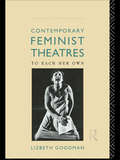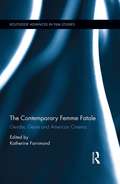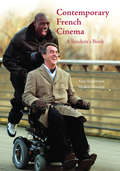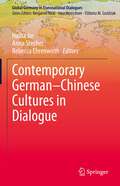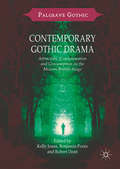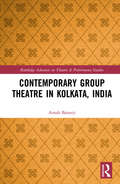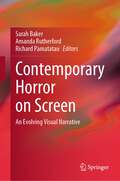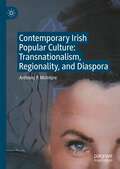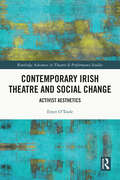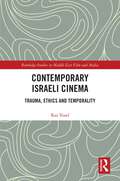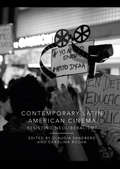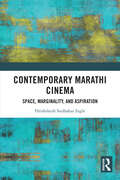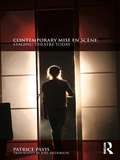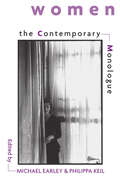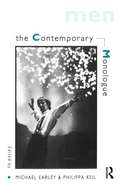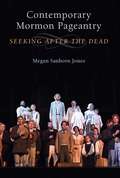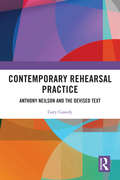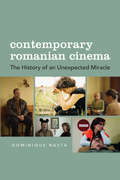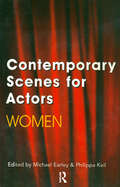- Table View
- List View
Contemporary Feminist Theatres: To Each Her Own (Gender in Performance)
by Lizbeth GoodmanContemporary Feminist Theatres is a major evaluation of the forms feminism has taken in the theatre since 1968. Lizbeth Goodman provides a provocative and interdisciplinary study of the development of feminist theatres in Britain. She examines the treatment of key issues such as gender, race, sexuality, language and power in performance. Based on original research and fresh data, Contemporary Feminst Theatres is a fully comprehensive and admirably clear analysis of a flourishing field of practice and inquiry.
The Contemporary Femme Fatale: Gender, Genre and American Cinema (Routledge Advances in Film Studies)
by Katherine FarrimondThe femme fatale occupies a precarious yet highly visible space in contemporary cinema. From sci-fi alien women to teenage bad girls, filmmakers continue to draw on the notion of the sexy deadly woman in ways which traverse boundaries of genre and narrative. This book charts the articulations of the femme fatale in American cinema of the past twenty years, and contends that, despite her problematic relationship with feminism, she offers a vital means for reading the connections between mainstream cinema and representations of female agency. The films discussed raise questions about the limits and potential of positioning women who meet highly normative standards of beauty as powerful icons of female agency. They point towards the constant shifting between patriarchal appropriation and feminist recuperation that inevitably accompanies such representations within mainstream media contexts.
Contemporary French Cinema: A Student's Book
by Alan J. Singerman Michèle BissièreLike its French-language companion volume Le Cinéma français contemporain: Manuel de classe, Alan Singerman and Michèle Bissière's Contemporary French Cinema: A Student's Book offers a detailed look at recent French cinema through its analyses of twenty notable and representative French films that have appeared since 1980. Sure to delight Anglophone fans of French film, it can be used with equal success in English-language courses and, when paired with its companion volume, dual-language ones.Acclaim for Le Cinéma français contemporain: Manuel de classe "From Le Dernier Métro to Intouchables, Bissière and Singerman cover the latest trends of French cinema, emphasizing context and analytical method as Singerman did in Apprentissage du cinéma français (Focus 2004). The authors offer a selection of films most French cinephiles will applaud, and they incorporate insights from some of the best critical work on French cinema. Students of French film will also find all the bibliographical pointers they need to dig deeper, and instructors will appreciate the pedagogical components included in the chapters." —Jonathan Walsh, Department of French Studies, Wheaton College, Massachusetts "This remarkable book comes to us from two seasoned teachers and critics and beautifully complements an earlier work, Alan Singerman's Apprentissage du cinéma français. The time period covered, more targeted here than in the preceding text, is admirably well chosen, and the breakdown by broad category, each offering multiple options, guides the teacher while offering a choice among an abundance of interesting films. The preliminary chapters, both succinct and informative, give students an excellent overview of French cinema as a whole and of the technical knowledge needed for film analysis. Each of the subsequent chapters offers an indispensable introduction discussing the plot, director, production, actors, reception, and context of the film in question and also provides a very useful filmography and bibliography… an exemplary work." —Brigitte E. Humbert, Department of French and Francophone Studies, Middlebury College
Contemporary German–Chinese Cultures in Dialogue (Global Germany in Transnational Dialogues)
by Haina Jin Anna Stecher Rebecca EhrenwirthThis book provides a unique perspective on contemporary German and Chinese cultural encounters. Moving away from highlighting exchanges between the two countries in terms of colonial connections, religious influences and philosophical impacts, the book instead focuses on the vast array of modern cultural dialogues that have influenced both countries, especially in literature, theatre and film. The book discusses issues of translation, adaptation, and reception to reveal a unique cultural relationship. The editors and contributors examine the existing programs and strategies for cultural interchange, and analyse how these shape or have shaped intercultural dialogue, and what kind of intercultural exchange is encouraged. This book is of interest to students and researchers of film and media studies, Sinophone studies, transnational studies, cultural studies and social and cultural anthropology.
Contemporary Gothic Drama: Attraction, Consummation and Consumption on the Modern British Stage (Palgrave Gothic)
by Kelly Jones Benjamin Poore Robert DeanThis ground-breaking volume is the first of its kind to examine the extraordinary prevalence and appeal of the Gothic in contemporary British theatre and performance. Chapters range from considerations of the Gothic in musical theatre and literary adaptation, to explorations of the Gothic’s power to haunt contemporary playwriting, macabre tourism and site-specific performance. By taking familiar Gothic motifs, such as the Gothic body, the monster and Gothic theatricality, and bringing them to a new contemporary stage, this collection provides a fresh and comprehensive take on a popular genre. Whilst the focus of the collection falls upon Gothic drama, the contents of the book will embrace an interdisciplinary appeal to scholars and students in the fields of theatre studies, literature studies, tourism studies, adaptation studies, cultural studies, and history.
Contemporary Group Theatre in Kolkata, India (Routledge Advances in Theatre & Performance Studies)
by Arnab BanerjiThis book is the first of its kind offering a materialistic semiotic analysis of a non-Western theatre culture: Bengali group theatre. Arnab Banerji fills two lacunas in contemporary theatre scholarship. First, the materialist semiotic approach to studying a non-Western theatre event allows Banerji to critically examine the material conditions in which theatre is created and seen outside the Euro-American context. And second, by shifting the critical lens onto a contemporary urban theatre phenomenon from India, the book attempts to even out the scholastic imbalance in Indian theatre scholarship which has largely focused on folk and classical traditions. The book shows a refreshing new perspective toward a theatre culture that frequently escapes the critical lens in spite of being one of the largest urban theatre cultures in the world. Theatre events are a sum total of the conditions in which they are built and the conditions in which they are viewed. Studying the event separate from its materialistic beginnings and semiotic effects allow only a partial insight into the performance phenomenon. The materialist semiotic critical framework of this book locates the Bengali group theatre within its performative context and offers a heretofore unexplored insight into this vibrant theatre culture.
Contemporary Horror on Screen: An Evolving Visual Narrative
by Sarah Baker Amanda Rutherford Richard PamatatauThis book highlights how horror in film and television creates platforms to address distinct areas of modern-day concern. In examining the prevalence of dark tropes in contemporary horror films such as Get Out, Annabelle: Creation, A Quiet Place, Hereditary and The Nun, as well as series such as Stranger Things, American Horror Story and Game of Thrones, amongst numerous others, the authors contend that we are witnessing the emergence of a ‘horror renaissance’. They posit that horror films or programmes, once widely considered to be a low form of popular culture entertainment, can contain deeper meanings or subtext and are increasingly covering serious subject matter. This book thus explores how horror is utilised as a tool to explore social and political anxieties of the cultural moment and is thus presented as a site for contestation, exploration and expansion to discuss present-day fears. It demonstrates how contemporary horror reflects the horror of modern-day life, be it political, biological, social or environmental. A vital contribution to studies of the horror genre in contemporary culture, and the effect it has on social anxieties in a threatening and seemingly apocalyptic time for the world, this is a vital text for students and researchers in popular culture, film, television and media studies.
Contemporary Irish Popular Culture: Transnationalism, Regionality, and Diaspora
by Anthony P. McIntyreThis book uses popular culture to highlight the intersections and interplay between ideologies, technological advancement and mobilities as they shape contemporary Irish identities. Marshalling case studies drawn from a wide spectrum of popular culture, including the mediated construction of prominent sporting figures, Troubles-set sitcom Derry Girls, and poignant drama feature Philomena, Anthony P. McIntyre offers a wide-ranging discussion of contemporary Irishness, tracing its entanglement with notions of mobility, regionality and identity. The book will appeal to students and scholars of Irish studies, cultural studies, as well as film and media studies.
Contemporary Irish Theatre: Histories and Theories
by Ian R. Walsh Charlotte McIvorThis open access book is a new survey of theatre practices in Ireland from 1957 to the present. Part I: Histories, situates the theatrical activity of twentieth and twenty-first century Ireland within its social and political contexts, identifies key practitioners, landmark productions, institutions, festivals, and seminal revivals. Part II: Theories, offers five key theoretical frameworks - nation, language, body, space and interculturalism - to examine contemporary Irish theatre practices. Contemporary Irish Theatre and Performance ultimately offers a more extensive story of contemporary Irish theatre documenting the diversity of practices and contributors that have populated the contemporary Irish theatre landscape since 1957.
Contemporary Irish Theatre and Social Change: Activist Aesthetics (Routledge Advances in Theatre & Performance Studies)
by Emer O'TooleThis book uses the social transformation that has taken place in Ireland from the decriminalisation of homosexuality in 1993 to the repeal of the 8th amendment in 2018 as backdrop to examine relationships between activism and contemporary Irish theatre and performance. It studies art explicitly intended to create social and political change for marginalised constituencies. It asks what happens to theatre aesthetics when artists’ aims are political and argues that activist commitments can create new modes of beauty, meaning, and affect. Categories of race, class, sexuality, and gender frame chapters, provide social context, and identify activist artists’ social targets. This book provides in depth analysis of: Arambe – Ireland’s first African theatre company; THEATREclub – an experimental collective with issues of class at its heart; The International Dublin Gay Theatre Festival; and feminist artists working to Repeal the 8th amendment. It highlights the aesthetic strategies that emerge when artists set their sights on justice. Aesthetic debates, both historical and contemporary, are laid out from first principles, inviting readers to situate themselves – whether as artists, activists, or scholars – in the delicious tension between art and life. This book will be a vital guide to students and scholars interested in theatre and performance studies, gender studies, Irish history, and activism.
Contemporary Israeli Cinema: Trauma, Ethics and Temporality (Routledge Studies in Middle East Film and Media)
by Raz YosefThrough analysis of the complex discourse surrounding trauma and loss, this book provides a necessary examination of temporality and ethics in Israeli film and television since the turn of the millennium. The author examines posttraumatic idioms of fragmentation and incoherence, highlighting the rising resistance towards generic categories, and the turn to unconventional and paradoxical structures with unique aesthetics. Maintaining that contemporary Israeli cinema has undergone an ethical shift, the author examines the revealing traumas and denied identities that also seek alternative ways to confront ethical question of accountability. It discusses the relationships between trauma, nationalism, and cinema through the intertwined perspectives of feminism, queer theory, and critical race and postcolonial studies, showing how national traumas are constructed by notions of gendered, sexual, and racial identity. This innovative text highlights the complexities of discourse surrounding trauma and loss, informed by multiple categories of difference. Across each chapter various elements of Israeli film are explored, spanning from strategies used to critically examine victim-perpetrator dynamics, co-existence in temporal space, women’s cinema in Israel, displacement, and queer communities and identity. Beyond its direct contribution to cinema studies and Israel studies, the book will be of interest to trauma and memory studies, postcolonial studies, gender and sexuality studies, Jewish studies, Middle Eastern studies, and cultural studies.
Contemporary Japanese Women’s Theatre and Visual Arts: Performing Girls’ Aesthetics (Contemporary Performance InterActions)
by Nobuko AnanThis book traces the history of 'girls' aesthetics,' where adult Japanese women create art works about 'girls' that resist motherhood, from the modern to the contemporary period and their manifestation in Japanese women's theatrical and dance performance and visual arts including manga, film, and installation arts.
Contemporary Latin American Cinema: Resisting Neoliberalism?
by Claudia Sandberg Carolina RochaContemporary Latin American Cinema investigates the ways in which neoliberal measures of privatization, de-regularization and austerity introduced in Latin America during the 1990s have impacted film production and film narratives. The collection examines the relationship between economic policies and the films that depict recent transformations in many Latin American countries, demonstrating how contemporary Latin American film has not only criticized and resisted, but also benefitted from neoliberal advancements. Based on films produced in Argentina, Bolivia, Brazil, Chile, Colombia, Ecuador, Mexico and Peru since 2010, the fourteen case studies illustrate neoliberalism’s effects, from big industries to small national cinemas. It also shows the new types of producers that have emerged, and the novel patterns of distribution, exhibition and consumption that shape and influence the Latin American filmscape. Through industry studies, reception analyses and close readings, this book establishes an informative and accessible text for scholars and students alike.
Contemporary Marathi Cinema: Space, Marginality, and Aspiration
by Hrishikesh Sudhakar InglePost-millennial Marathi cinema is a dynamic and expanding practice that is celebrated as a “new-wave” but has not received much critical engagement. This book presents the first comprehensive inquiry of contemporary films and examines their textual, industrial, and cultural intersections to understand what constitutes the “new-ness” of Marathi cinema. Establishing the vernacular particularity of Marathi cinema, the book argues that newage films are actively engaged in a reflexive intellectual and social critique as a mark of new filmmaking in India. In the diversity of genres and topics handled by Marathi filmmakers since 2004 this study identifies four broad affective topographies for analysis – an imagery of nostalgia underpinning the narrative strategies of Marathi films, the articulation of social aspiration as a theme as well as a societal dialectic, an experiential reflexivity in the representation of Dalit and marginal narratives, and a mediatic network of border-crossings through transnational influences on films.Contemporary Marathi Cinema: Space, Marginality, and Aspiration offers a critical dialogue on broad issues of film policy, multiplex economics, genre forms, queer politics, and neoliberal contexts. It will be indispensable to students and researchers of Indian cinemas, regional filmmaking, media, cultural studies, popular culture and performance, literature, and South Asian studies, and will also be of interest to filmmakers and cinephiles.
Contemporary Mise en Scène: Staging Theatre Today
by Patrice Pavis‘We have good reason to be wary of mise en scène, but that is all the more reason to question this wariness ... it seems that images from a performance come back to haunt us, as if to prolong and transform our experience as spectators, as if to force us to rethink the event, to return to our pleasure or our terror.’ – Patrice Pavis, from the foreword Contemporary Mise en Scène is Patrice Pavis’s masterful analysis of the role that staging has played in the creation and practice of theatre throughout history. This stunningly ambitious study considers: the staged reading, at the frontiers of mise en scène; scenography, which sometimes replaces staging; the reinterpretation of classical and contemporary works; the development of intercultural theatre and ritual; new technologies and their usage live on the stage; the postmodern practice of deconstruction. But it also applies sustained critical attention to the challenges of defining mise en scène, of tracking its development, and of exploring its possible futures. Joel Anderson’s powerful new translation lucidly realises Pavis’s investigation of the changing possibilities for stagecraft in the context of performance art, physical theatre and modern theory.
The Contemporary Monologue: Women
by Michael EarleyFirst published in 1995. Routledge is an imprint of Taylor & Francis, an informa company.
The Contemporary Monologue: Men (Monologue And Scene Bks.)
by Michael Earley Philippa KeilFirst Published in 1995. Routledge is an imprint of Taylor & Francis, an informa company.
Contemporary Mormon Pageantry: Seeking After the Dead
by Megan S JonesIn Contemporary Mormon Pageantry, theater scholar Megan Sanborn Jones looks at Mormon pageants, outdoor theatrical productions that celebrate church theology, reenact church history, and bring to life stories from the Book of Mormon. She examines four annual pageants in the United States-the Hill Cumorah Pageant in upstate New York, the Manti Pageant in Utah, the Nauvoo Pageant in Illinois, and the Mesa Easter Pageant in Arizona. The nature and extravagance of the pageants vary by location, with some live orchestras, dancing, and hundreds of costumed performers, mostly local church members. Based on deep historical research and enhanced by the author's interviews with pageant producers and cast members as well as the author's own experiences as a participant-observer, the book reveals the strategies by which these pageants resurrect the Mormon past on stage. Jones analyzes the place of the productions within the American theatrical landscape and draws connections between the Latter-day Saints theology of the redemption of the dead and Mormon pageantry in the three related sites of sacred space, participation, and spectatorship. Using a combination of religious and performance theory, Jones demonstrates that Mormon pageantry is a rich and complex site of engagement between theater, theology, and praxis that explores the saving power of performance.
Contemporary Performance and Political Economy: Oikonomia as a New Ethico-Political Paradigm (Routledge Advances in Theatre & Performance Studies)
by Katerina ParamanaContemporary Performance and Political Economy examines haunting concepts, relations, and artworks that demand our attention. Under capitalism, political and ethical considerations are subordinated to economic ones, and this subordination creates ghost worlds. Performance works, however, can offer insights into alternative politico-economic models. In this major contribution to the fields of contemporary performance and political economy, Katerina Paramana proposes that the investigation of performance works as economies can make the insights performance works offer visible. She positions the examination in relation to contemporary critiques of capitalism, neo-feudalism, and their by-products, and proposes and develops the notion of "oikonomia" as a means to theorize artworks which, through their house (oikos) rules (nomoi), propose ethico-political challenges to the economies in which they are embedded. For this, Paramana looks at politically positioned performance works created and presented in Cuba, Europe, Mexico, the UK, and the US. Her interest is in the politics, ethics, and effects of these works’ "house rules", and the insights they offer to the reconceptualization of political economy. Ultimately, this book aims to transform our understanding of economy’s purpose. It contributes to the development of a new ethico-political paradigm upon which a reconceptualization of political economy can be based. This inspiring study seeks to keep the fire for change alive by demonstrating that political economies, much like performances, are experiments that can be changed.This work will be of great interest to students and scholars in performance studies, theatre, visual cultures, politics, cultural studies, dance, and visual arts, and critical theorists.
Contemporary Plays by Women of Color: An Anthology
by Roberta UnoContemporary Plays by Women of Color is a ground-breaking anthology of eighteen new and recent works by African American, Asian American, Latina American and Native American playwrights. This compelling collection includes works by award-winning and well-known playwrights such as Anna Deavere Smith, Cherrie Moraga, Pearl Cleage, Marga Gomez and Spiderwoman, as well as many exciting newcomers. Contemporary Plays by Women of Color is the first anthology to display such an abundance of talent from such a wide range of today's women playwrights. The plays tackle a variety of topics - from the playful to the painful - and represent numerous different approaches to playmaking. The volume also includes: * an invaluable appendix of published plays by women of color * biographical notes on each writer * the production history of each play Contemporary Plays by Women of Color is a unique resource for practitioners, students and lovers of theatre, and an inspiring addition to any bookshelf.
Contemporary Rehearsal Practice: Anthony Neilson and the Devised Text
by Gary CassidyThis book provides the first comprehensive study of Anthony Neilson’s unconventional rehearsal methodology. Neilson’s notably collaborative rehearsal process affords an unusual amount of creative input to the actors he works with and has garnered much interest from scholars and practitioners alike. This study analyses material edited from 100 hours of footage of the rehearsals of Neilson’s 2013 play Narrative at the Royal Court Theatre, as well as interviews with Neilson himself, the Narrative cast, and actors from other Neilson productions. Replete with case studies, Gary Cassidy also considers the work of other relevant practitioners where appropriate, such as Katie Mitchell, Forced Entertainment, Joan Littlewood, Peter Brook, Complicite’s Simon McBurney, Stanislavski and Sarah Kane. Contemporary Rehearsal Practice will be of great interest to scholars, students and practitioners of theatre and performance and those who have an interest in rehearsal studies.
Contemporary Representations of Forced Migration in Europe: Beyond Regime and Refuge (Palgrave Studies in Literature, Culture and Human Rights)
by Fiona Barclay Beatrice IveyThis book engages with current debates around refugeedom by examining cultural production that represents and interrogates the construction of refugees and the refugee experience on the borders of contemporary Europe. The refugee subject is produced by discursive regimes and border practices inherited from colonial projects that construct the diametrically opposed concepts of citizen and refugee, and their attendant administrative sub-categories. In the early twenty-first century these categories have been strengthened by the politicisation of forced migration and the hardening of ‘Fortress Europe’. While the predominant response to the increasing numbers of refugees seeking asylum in Europe has been to harden the borders (regime), on the one hand, or to stress the common humanity of those displaced (refuge), on the other, this volume argues that both approaches result in refugees becoming objectified, othered, and abstracted as vectors ofexile. It explores what recent cultural production can achieve in engaging with and representing issues of dispossession, detention and resettlement, and probes the limits of artistic potential to mediate the refugee experience. It examines transnational approaches to cultural production that both occupy and exceed the borders of Europe, with a focus on borderscapes, spaces of detention, and (neo-)colonialism. Bringing together original contributions from an international range of scholars, it analyses contemporary textual and visual representations of forced migration to argue that other forms of solidarity and hospitality towards refugees in Europe and beyond must be possible.
Contemporary Romanian Cinema: The History of an Unexpected Miracle
by Dominique NastaOver the last decade, audiences worldwide have become familiar with highly acclaimed films from the Romanian New Wave such as 4 Months, 3 Weeks and 2 Days (2007), The Death of Mr. Lazarescu (2005), and 12:08 East of Bucharest (2006). However, the hundred or so years of Romanian cinema leading to these accomplishments have been largely overlooked. This book is the first to provide in-depth analyses of essential works ranging from the silent period to contemporary productions. In addition to relevant information on historical and cultural factors influencing contemporary Romanian cinema, this volume covers the careers of daring filmmakers who approached various genres despite fifty years of Communist censorship. An important chapter is dedicated to Lucian Pintilie, whose seminal work, Reconstruction (1969), strongly inspired Romania's 21st-century innovative output. The book's second half closely examines both the 'minimalist' trend (Cristian Mungiu, Cristi Puiu, Corneliu Porumboiu, Radu Muntean) and the younger, but no less inspired, directors who have chosen to go beyond the 1989 revolution paradigm by dealing with the complexities of contemporary Romania.
Contemporary Romanian Cinema
by Dominique NastaOver the last decade, audiences worldwide have become familiar with highly acclaimed films from the Romanian New Wave such as 4 Months, 3 Weeks and 2 Days (2007), The Death of Mr. Lazarescu (2005), and 12:08 East of Bucharest (2006). However, the hundred or so years of Romanian cinema leading to these accomplishments have been largely overlooked. This book is the first to provide in-depth analyses of essential works ranging from the silent period to contemporary productions. In addition to relevant information on historical and cultural factors influencing contemporary Romanian cinema, this volume covers the careers of daring filmmakers who approached various genres despite fifty years of Communist censorship. An important chapter is dedicated to Lucian Pintilie, whose seminal work, Reconstruction (1969), strongly inspired Romania's 21st-century innovative output. The book's second half closely examines both the 'minimalist' trend (Cristian Mungiu, Cristi Puiu, Corneliu Porumboiu, Radu Muntean) and the younger, but no less inspired, directors who have chosen to go beyond the 1989 revolution paradigm by dealing with the complexities of contemporary Romania.
Contemporary Scenes for Actors: Women
by Michael Earley Philippa KeilFirst Published in 1999. Routledge is an imprint of Taylor & Francis, an informa company.
